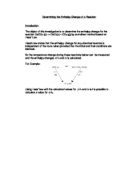Results
For the Run A with 2 cm3 propanone, 4 cm3 sulphuric acid and 13 cm3 water and 1 cm3 Iodine
The graph for [I3-] gives a straight line graph; therefore, the gradient can be worked out to be:
-7.13 x 10-3
For Run A, k1 can now be worked out using the equation:
Rate = k1 [I3-]p
-7.13 x 10-3 = k1 [0.1]0
k1 = -7.13 x 10-3
[0.1]0
k1 = -7.13 x 10-3
For Run B, k1 can be worked out as:
k1 = -6.7 x 10-3
[0.1]0
k1 = -6.7 x 10-3
For Run C, k1 can be worked out as:
k1 = -5 x 10-4
[0.1]0
k1 = -5 x 10-4
With these values, the three equations can now be shown as:
However, in order to work out m and n, the concentrations for each run need to be worked out; the workings below are for Run A:
Propanone has a liquid density of 0.79g cm-3, and it molecular mass can be worked out to be 58; therefore 1 cm3 can be worked out to be:
Mol = Mass
Molecular Mass
Mol = 0.79
58
Mol = 0.0136
Therefore, in this run, the propanone has a concentration of 0.0272 mol dm-3. Therefore, the concentration of propanone in 20 cm3 can be worked out to be:
Concentration = Mol
Volume
Concentration = 0.0272
0.020
Concentration = 1.36 mol dm-3
Also in Run A, the concentration of the sulphuric acid can be worked out to be:
Concentration = 1 x 0.020
Concentration = 0.020 mol dm-3
For Run B, the propanone concentration can be worked out as 0.68 mol dm-3, the sulphuric acid remains the same and is 0.020 mol dm-3.
Lastly, for Run C the propanone concentration can be worked out as 0.68 mol dm-3, and the sulphuric acid concentration can be worked out as 0.01 mol dm-3.
Therefore, the final equations are shown below:
With equations A and B, it is possible to work out m. The calculations for this are shown below:
7.13 x 10-3 = k [1.36]m [0.020]n
6.7 x 10-3 = k [0.68]m [0.020]n
Once the cancellations have been made, the equation can now be worked out as:
6.7 x 10-3 = [0.68]m
7.13 x 10-3 = [1.36]m
0.94 = 0.5m
m = log 0.94
log 0.5
m = 0.08
m = 1
In order to work out n, equations B and C can be used. The calculations are shown below:
5 x 10-4 = k [0.68]m [0.01]n
6.7 x 10-3 = k [0.68]m [0.020]n
Once the cancellations have been made, the equation can now be worked out as:
5 x 10-4 = k [0.01]n
6.7 x 10-3 = k [0.020]n
0.0746 = 0.5
n = log 0.075
log 0.5
n = 3.73
n = 4
Therefore, using equation A, k can be worked out as:
7.13 x 10-3 = k [1.36]1 [0.020]4
k = 7.13 x 10-3
[1.36]1 [0.020]4
k = 7.13 x 10-3
1.6 x 10-7
k = 44562.5 mol dm-3 s-1
This being such a large number, would indicate that either the calculations have been worked out incorrectly or the practical results were incorrect.
Questions
- Given the form of the rate equation that you have worked out, what species do you think are involved in the rate determining step?
The species that may be involved in the rate determining step, I feel, would be the propanone. This is due to the fact that when the concentration of the propanone increased the reaction quickened.
-
If you had doubled the I3- concentration, how would this have affected the measured k1?
There would be no change in the k1 results due to the fact that the reaction would stay the same if the iodide concentration was doubled.







